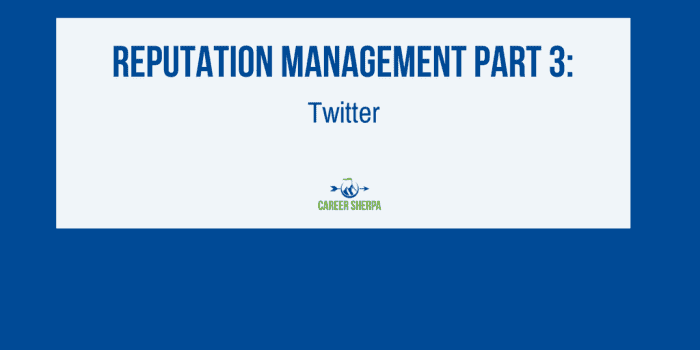This is part 3 of a 3 part series in reputation management across social media. This is post is about the benefits of being on Twitter.
Part 1 was about building your reputation by fully utilizing your profile on LinkedIn. Part 2 was about blogging and commenting on blogs.
I recently gave a presentation on how to use multiple social media tools to build and manage an online reputation and only lightly covered Twitter. I watched eyes roll and heads shake as I began referencing Twitter. It is a highly misunderstood tool. My words of caution are “Don’t knock it until you’ve tried it” and “Twitter is only stupid if you aren’t following smart people”. Let’s enter into this with an open mind.
Let’s enter into this with an open mind.
With any new piece of technology, there are early adopters. What this means for early adopters is that it is easier to become a big fish in a little pond, or it is easier to become recognized when there isn’t as much competition. Don’t you want to stand out?
Twitter is open and viewable by everyone. This is a good thing as long as you understand the benefits and dangers of what this means.
Basic Principles For Using Twitter
Social is the key word here as we talk about Twitter. You could almost look at it like a networking event. Getting a lay of the land, listening, and meeting new people is kind of what this is all about.
Listen: See what people are saying on Twitter. See how people describe themselves in their profile. See how they use Twitter language and code. Observe for awhile.
Share: There is a lot of information being shared on Twitter. Personal and professional. Skim the stream for the gems (usually contributed by smart folks). You will eventually want to share as well so be on the lookout for articles and information on the web that others would be interested in learning about.
Respond: We’ve got some basic etiquette on Twitter. Thank people for mentioning you. Be polite and professional. Don’t spam. Simple, right. Taking this “respond” concept one step further, offer help to those who need it (remember the “give to get” theory?)
OK, you’re ready to get started.
Twitter Best Practices
These were the “Best Practices” Twitter had on their site (at one time, but I can’t find these points any longer)
- Share. Share photos and behind the scenes info about your business. Even better, give a glimpse of developing projects and events. Users come to Twitter to get and share the latest, so give it to them!
- Listen. Regularly monitor the comments about your company, brand, and products.
- Ask. Ask questions of your followers to glean valuable insights and show that you are listening.
- Respond. Respond to compliments and feedback in real time
- Reward. Tweet updates about special offers, discounts and time-sensitive deals.
- Demonstrate wider leadership and know-how. Reference articles and links about the bigger picture as it relates to your business.
- Champion your stakeholders. Re-tweet and reply publicly to great tweets posted by your followers and customers.
- Establish the right voice. Twitter users tend to prefer a direct, genuine, and of course, a likable tone from your business, but think about your voice as you Tweet. How do you want your business to appear to the Twitter community?
Getting Started is as easy as 1, 2, 3
1. Your Profile:
Use your messaging (what you want to be known for) in the 160 characters you have to describe yourself in you Twitter profile! Use the same headshot you’ve used on LinkedIn and other profiles. Include the URL (website) for the best place for people to learn about you. This could be LinkedIn or it could be your own site.
This is how people come to know you! It should be complete and authentic!
2. Your first few Tweets
If you were to be known for sharing great information (a book, an article, an event, a quote) what would that be? Your first tweets should be representative of who you are, what is important to you, and what you want to be known for. Your profile and your recent tweets will be what people see. It should always be the right message
3. Find and Follow
Finding what I like to call “smart” people on Twitter can happen in many ways. In order for you to get the most from Twitter as you begin, follow people you know (or would like to know) respect, or find interesting.
Try It!
10 minutes each day, for at least 30 days, try doing some of these things:
- Look for interesting information to Retweet (RT means share) It complements the original Tweeter.
- Answer someone’s question
- Share an interesting article
- Read what other people are doing and Reply to their Twitter update
- Follow new followers and find new people to follow
That should do it- as long as you commit to doing it daily. You don’t want to miss what is going on and what people are up to!
Twitter is about being social!
- Building relationships
- Establishing a reputation
- Sharing information
- Learning
Reputation Management Part 4 Facebook for Job Search! Learn how Facebook helps you stay connected and manage your reputation among your closest allies!

Hannah Morgan speaks and writes about job search and career strategies. She founded CareerSherpa.net to educate professionals on how to maneuver through today’s job search process. Hannah was nominated as a LinkedIn Top Voice in Job Search and Careers and is a regular contributor to US News & World Report. She has been quoted by media outlets, including Forbes, USA Today, Money Magazine, Huffington Post, as well as many other publications. She is also author of The Infographic Resume and co-author of Social Networking for Business Success.


